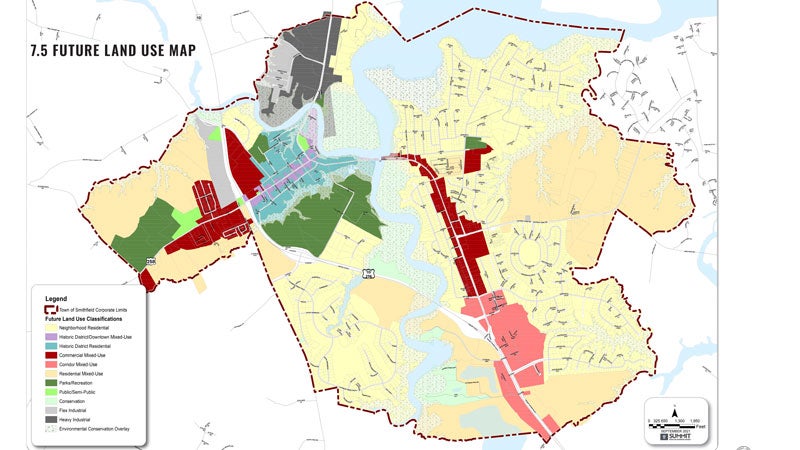Smithfield adopts new comprehensive plan
Published 12:18 pm Friday, July 8, 2022

- The future land use map in Smithfield's 2022 comprehensive plan shows some areas shaded in dark red as "commercial mixed-use," which, according to the plan, is to take its design cues from the existing historic district. Courtesy | Town of Smithfield
Smithfield’s Town Council gave final approval to the town’s new comprehensive plan on July 5.
The town worked with Summit Design and Engineering for over a year to create the document, which will guide land use decisions for years to come. The previous plan hadn’t seen major changes since 2009.
Per state law, a locality’s comprehensive plan must be revisited at least once every five years “to determine whether it is advisable to amend the plan.”
The new plan lists, among its top goals, creating a more walkable South Church Street east of the Pagan River and reducing traffic throughout town, which the document contends can be achieved by “prioritizing” bicycles and pedestrians.
The South Church Street corridor, where one of the town’s two grocery stores is located, is “particularly inhospitable for pedestrian and bicycle access,” the plan states.
In accordance with the plan’s walkability focus, the future land use map shows areas along the South Church Street and West Main Street corridors, the Riverside Healthy Living Community on John Rolfe Drive and the former 1730s Pierceville farm and Little’s Supermarket at the western edge of the town’s historic district shaded in dark red as “commercial mixed-use.”
The commercial mixed-use designation, according to the plan, is intended to serve as an “extension” of Smithfield’s historic area that would include a mix of commercial uses. Development in the designated mixed-use areas is to “take its cues from the historic downtown in architectural character and materials, and address the improved streetscape of wide sidewalks, lighting, and bicycle infrastructure.”
The draft plan further calls for more affordable and multifamily housing, alleging a racial disparity in Smithfield’s current housing market.
According to the document, 17% of Smithfield’s residents live below the poverty line, compared to just under 10% statewide and just over 12% nationwide. In spite of this, the median home value in Smithfield as of 2020 was just over $284,000 – a figure on par with the statewide median but higher than the U.S. median of just over $235,000.
Across the United States, “Black residents are more likely to fall below the poverty line,” and “that trend is visible in Smithfield,” the document states. In the town, 9.2% of white residents and 31% of Black residents fall below the poverty line, compared to statewide poverty rates of 7.9% for whites and 16.4% for African Americans.
No one spoke for or against the document at a public hearing the council held ahead of its unanimous approval vote.





